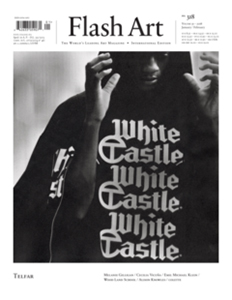New York–based
fashion label Telfar; Eli Diner on the proleptic videos of Melanie Gilligan; Julia Bryan-Wilson on the fleeting-yet-emphatic
multimedia art of
Cecilia Vicuña; Daniel Horn on
Emil Michael Klein's canny abstraction; Ronald Rose-Antoinette on the Wood Land School's yearlong decolonization of SBC Gallery; Cristina Guadalupe Galván talks to home-based artist
Alison Knowles; Pierre-Alexandre Mateos & Charles Teyssou bid adieu to the hyperglycemic concept store Colette; exhibitions reviews.
The cover story of this issue is dedicated to the New York–based fashion label Telfar. Founded in 2005 by Liberian American designer Telfar Clemens, the label is the recipient of the 2017 CFDA/Vogue Fashion Fund's prize for emerging talents in the fashion industry. Telfar is plural and genderless. The label's agenda for a “horizontal” clothing company not only defies the threat of elitism that even the most progressive and experimental fashion labels seem to strengthen; it challenges the very dialectics of top-drawer and fast fashion, street and high: in the words of Kevin McGarry, who profiles Telfar for the issue, Clemens's clothes “game mass culture to the point of true subversion.”
A call for a society founded on pluralism recurs across many of the stories featured in this issue; here's hoping that 2018 will be, as Telfar would say, “not for you — for everyone.”
Flash Art is a contemporary art and culture magazine founded in 1967. Within a decade, it became an indispensable point of reference for artists, critics, collectors, galleries, and institutions. In 2020, Flash Art became a quarterly publication, at the same time increasing its trim size and updating its graphic identity. The magazine offers a fresh perspective on the visual arts, covering a range of transdisciplinary approaches and fostering in-depth analyses of artist practices and new cultural directions. Today, Flash Art remains required reading for all who navigate the international art scene.
Flash Art is known for it covers featuring artists who subsequently become leading figures in the art world. The magazine includes photoshoots, productions, critical essays, monographic profiles, conversations with emerging and established artists, and a range of ongoing and thematic columns that change every few years. The long history of the magazine is also highlighted by pivotal texts from the archive that are included in the publication time to time. Finally, every issue offers a highly curated selection of the best institutional exhibitions on the global scene.

